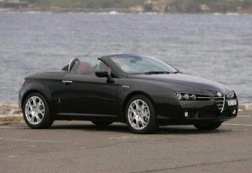Proton is jumping on the popular light-car segment in Australia by reintroducing the Satria after a two-year absence. The Satria (which means warrior), joins Proton's other small cars, the Saavy and Gen-2. While the new model may not exactly be up to Braveheart "warrior" standard, it is up to the benchmark of other cars in its class.
The Satria Neo, as it is now called, is available in two specification levels: the GX, starting at $18,990 and the GXR at $20,990, both drive-away prices. That's dearer than the likes of Toyota Yaris and Hyundai Getz but Proton is pitching the Satria further up the ladder, against the Volkswagen Polo and Ford Fiesta.
The three-door hatch features a revised and redeveloped 1.6-litre, four-cylinder CamPro engine, with 82kW of power at 6000rpm and 148Nm of torque at 4000rpm. Don't expect a thrilling ride, but for a car priced under $20,000, it's not bad, either. This is only the third car the Malaysian brand has fully developed using its own engineering and design team, as well as drawing on the expertise of connected brand, Lotus.
The Satria Neo is attractive. It incorporates its own design mixed with some familiar elements from other small cars. Proton claims a European influence in the styling.
Both models have a similar exterior, but for an extra $2000 for the GXR, you feel a bit short changed. You want something that advertises your superior status, apart from the rear spoiler. Alloy wheels are the only other physical difference, although even these aren't very different in design.
The exhaust, on the other hand, is a real stand-out, with the single-mounted chrome tail pipe located smack bang in the middle of the Satria's posterior.
On the inside, it feels a bit small, especially in the back seats. It has one of the tiniest gloveboxes so you can forget about storing accessories (although, I guess, it would fit a pair of gloves). Further storage is a stretch, with only cup holders in the middle and no real area to store wallets or mobile phones.
The layout of the centre console is simple, but it seems to work. Proton claims it has gone with the Lotus minimalist concept on the interior. The airconditioning is basic and, in the GX model, struggles on a typical Australian summer day.
The boot continues the minimal storage theme, and a relatively low roof means reduced interior space. So no, it's not a great car for a tall person.
In terms of handling and ride comfort, the Satria is impressive for a small car. This is largely because of its Lotus DNA. It wears a small badge on the back advertising this.
The new Proton boasts an entirely new, stronger platform and is an evolution from the previous best-selling Satria GTi, the performance model.
On the road, the Satria Neo grips well and takes corners at faster speeds soundly.
The five-speed manual transmission is smooth with a high gear ratio.
Both specifications are also available in a four-speed auto for an extra $1000, which has been improved with smoother shifting and a more even power distribution.
Taking into account the type of car this is, its performance is certainly reasonable. But you do notice it's just missing that extra bit of life to make it a truly enjoyable ride. The car hits peak power at 6000rpm, which takes a while to get to, especially on slight inclines.
There's a fair bit of road noise, especially on the entry-level model GX, with the inferior tyres. The Continental SportContact-2 tyres on the GXR are slightly better.
The Satria also uses new materials to reduce noise levels in the cabin.
The equipment list is impressive, with ABS and electronic brakeforce distribution, dual front airbags, airconditioning, electric windows, power steering, rear sensors and a CD player all standard.
The GXR adds a rear spoiler, front integrated fog lamps and 16-inch alloy wheels, as well as cruise control on the auto only.
It has a claimed 7.2-litres per 100km for the manual, 7.6-litres for the auto, although our test on winding roads, mixed with some quiet town driving, saw a reading of 8.6-litres per 100km, and 8.2-litres on the return highway, combined city trip. That extra power may not be far off, with a new GTi model a possibility for the near future. Proton is forecasting 600 sales for the year.
While Satria Neo has given off a decent first impression, although a little pricey, only time will tell if this Malaysian trouper has the durability and tenacity of a real warrior.
Proton Satria 2007: GX
| Engine Type | Inline 4, 1.6L |
|---|---|
| Fuel Type | Unleaded Petrol |
| Fuel Efficiency | 7.2L/100km (combined) |
| Seating | 5 |
| Price From | $2,420 - $3,850 |
Range and Specs
| Vehicle | Specs | Price* |
|---|---|---|
| GX | 1.6L, Unleaded Petrol, 4 SPEED AUTOMATIC | $2,640 - $4,070 |
| GX | 1.6L, Unleaded Petrol, 5 SPEED MANUAL | $2,420 - $3,850 |
| GXR | 1.6L, Unleaded Petrol, 4 SPEED AUTOMATIC | $2,640 - $4,070 |

















































.jpg)


Comments